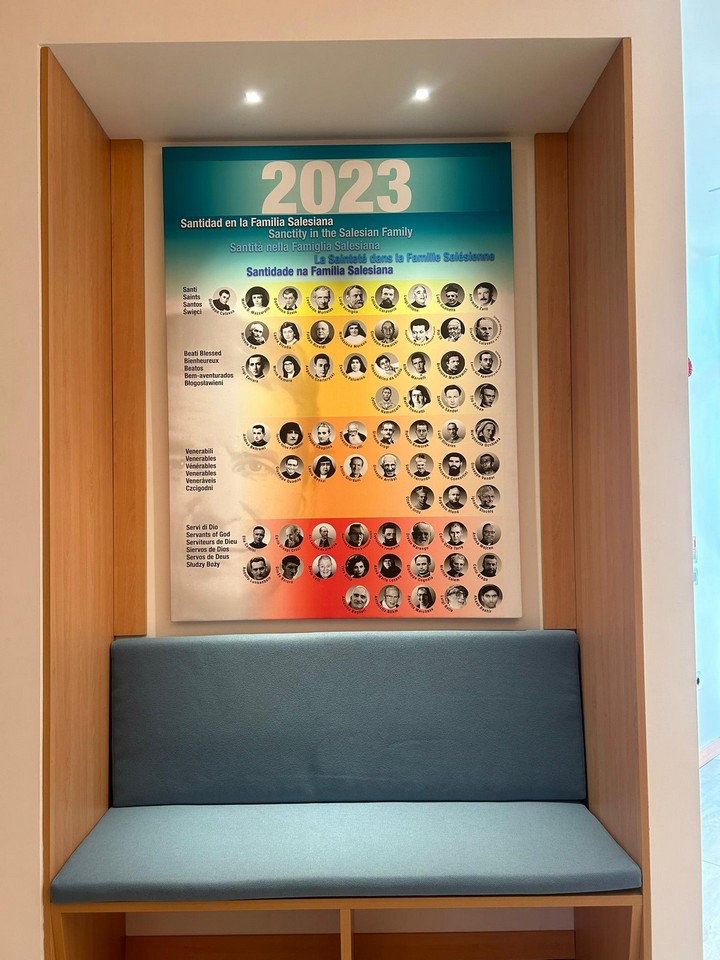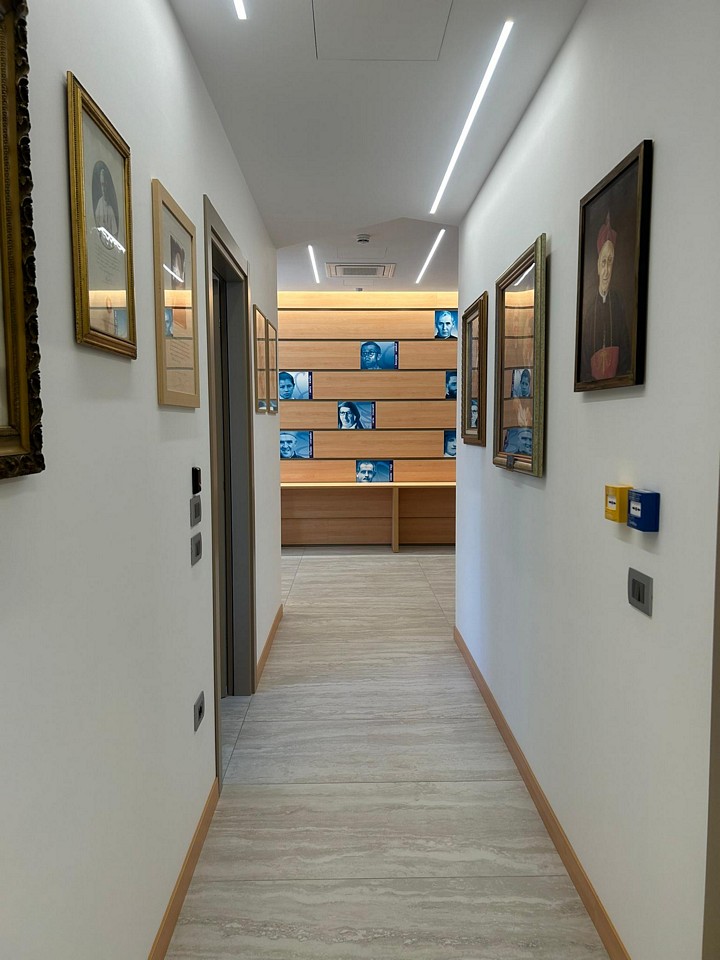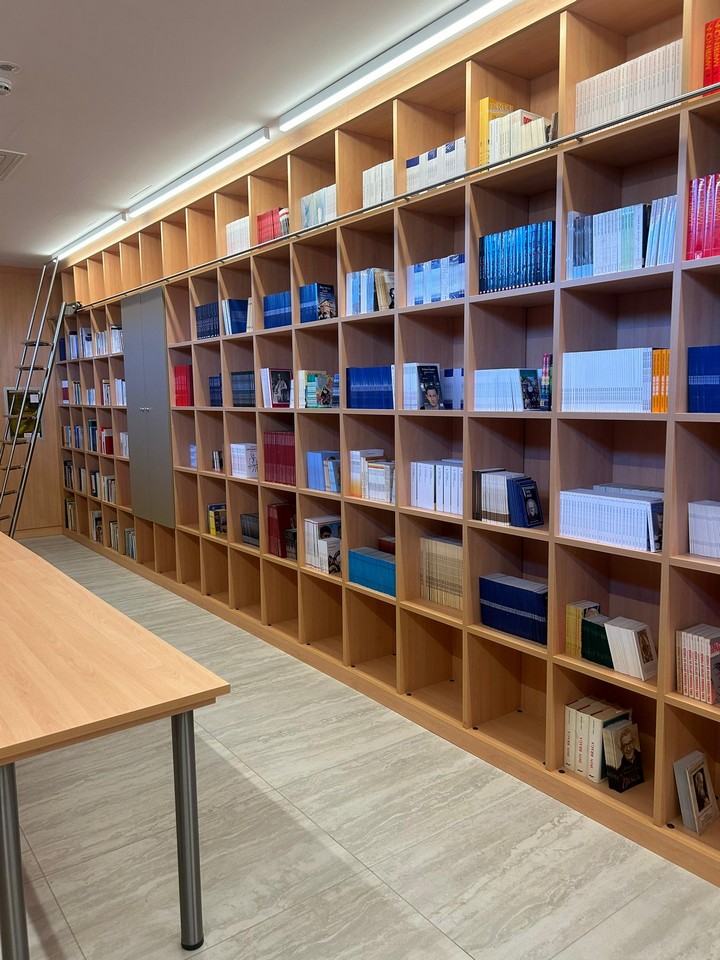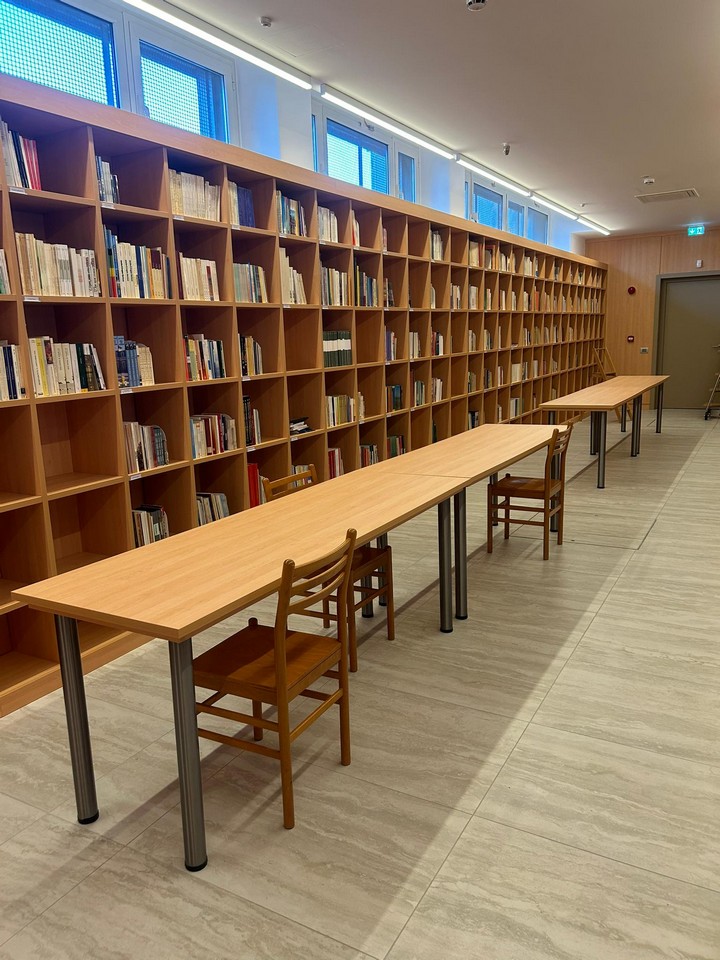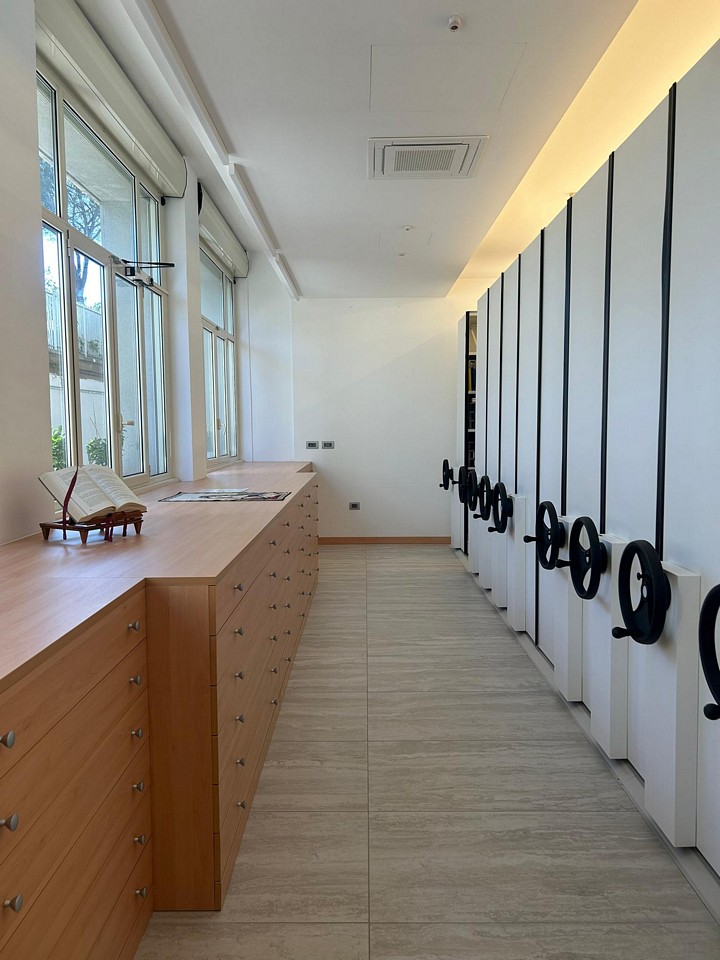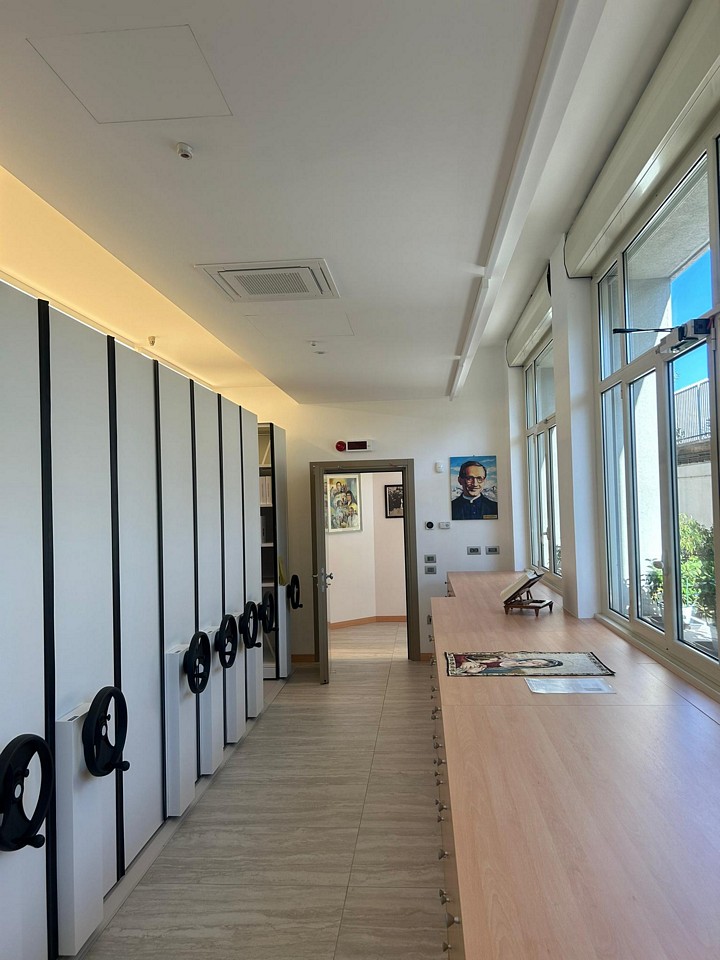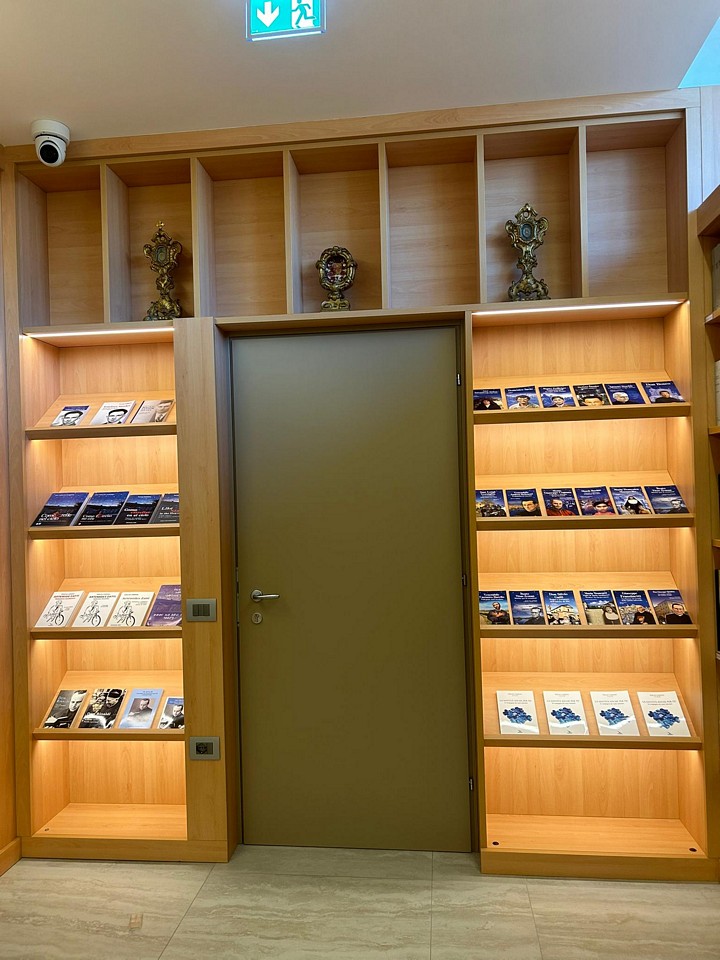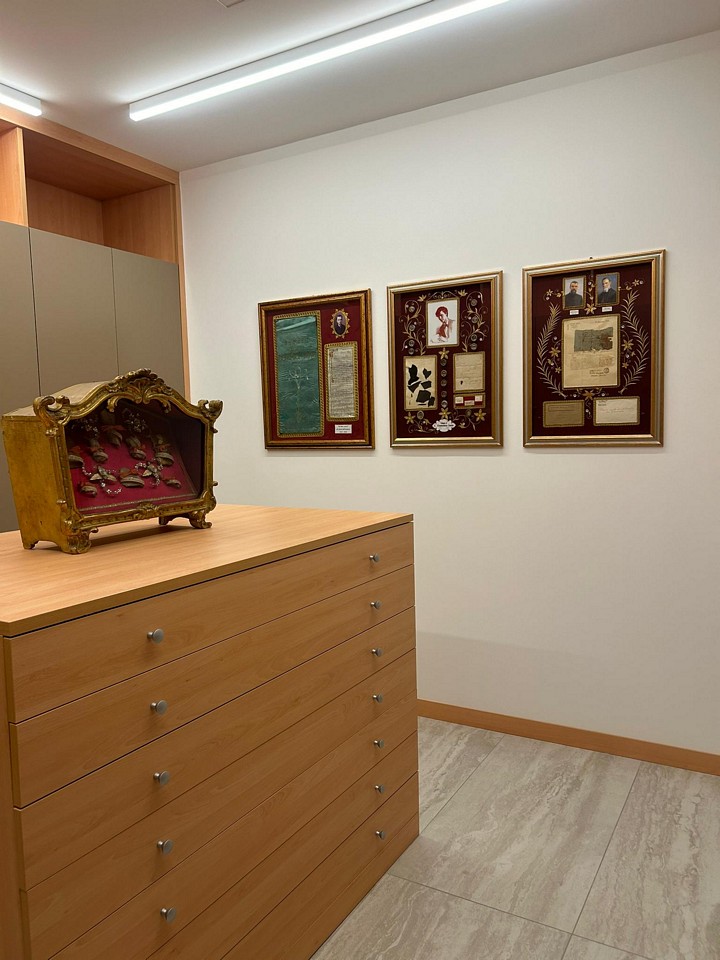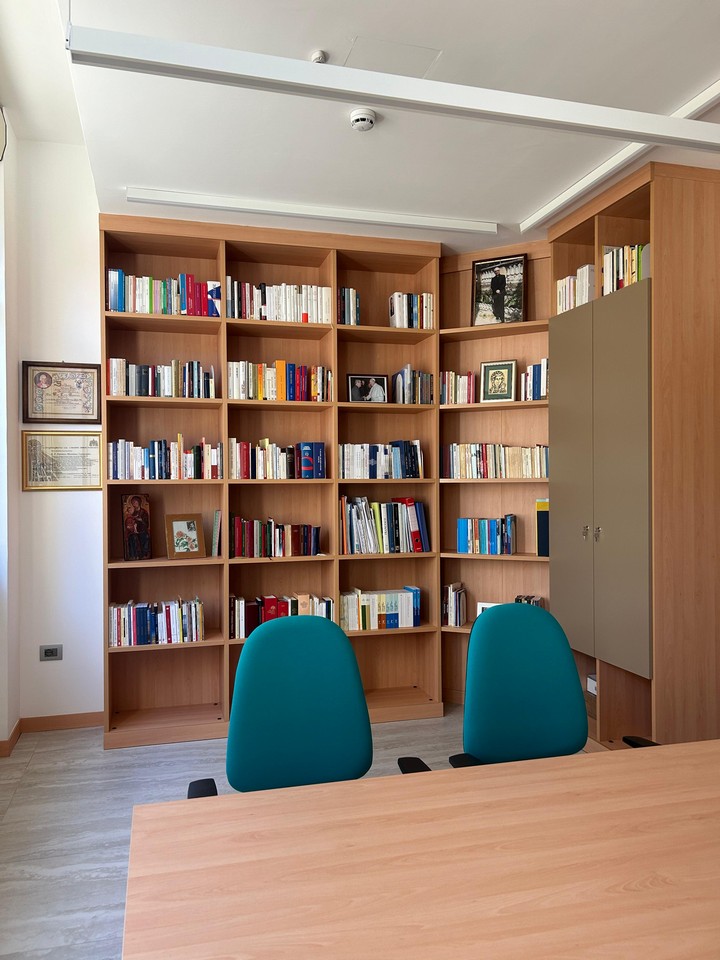Stefano Sándor (Szolnok 1914 – Budapest 1953) was a Salesian coadjutor martyr. A cheerful and devout young man, he studied metallurgy before joining the Salesians, becoming a master printer and mentor to boys. He enlivened youth centres, founded Catholic Workers’ Youth, and transformed trenches and construction sites into “festive oratories”. When the communist regime confiscated Church institutions, he continued educating and saving young people and machinery in secret. Arrested, he was hanged on 8 June 1953. Rooted in the Eucharist and devotion to Mary, he embodied the Gospel radicalism of Don Bosco through educational dedication, courage, and unshakable faith. Beatified by Pope Francis in 2013, he remains a model of Salesian lay holiness.
1. Biographical Notes
Sándor Stefano was born in Szolnok, Hungary, on 26 October 1914, to Stefano and Maria Fekete, the first of three brothers. His father was an employee of the State Railways, while his mother was a housewife. Both instilled a deep religiosity in their children. Stefano studied in his hometown, obtaining a diploma as a metallurgical technician. From a young age, he was respected by his peers; he was cheerful, serious, and kind. He helped his younger siblings study and pray, setting an example himself. He fervently received Confirmation, committing to imitate his patron saint and Saint Peter. He served daily Mass with the Franciscan Fathers, receiving the Eucharist.
While reading the Salesian Bulletin, he learned about Don Bosco. He felt immediately drawn to the Salesian charism. He discussed it with his spiritual director, expressing his desire to enter the Salesian Congregation. He also spoke to his parents about it. They denied him consent and tried in every way to dissuade him. But Stefano managed to convince them, and in 1936 he was accepted at the Clarisseum, the Salesians’ headquarters in Budapest, where he spent two years in the Aspirantate. He attended printing courses at “Don Bosco” printing house. He began the novitiate but had to interrupt it due to being called to arms.
In 1939, he obtained his final discharge and, after a year of novitiate, made his first Profession on 8 September 1940, as a Salesian Coadjutor. Assigned to the Clarisseum, he actively engaged in teaching in vocational courses. He was also responsible for assisting at the oratory, which he led with enthusiasm and competence. He was the promoter of the Catholic Youth Workers. His group was recognized as the best in the movement. Following Don Bosco’s example, he proved to be a model educator. In 1942, he was called back to the front and earned a silver medal for military valor. The trench was for him a festive oratory that he animated in a Salesian manner, encouraging his fellow soldiers. At the end of World War II, he committed himself to the material and moral reconstruction of society, dedicating himself particularly to the poorest youth, gathering them to teach them a trade. On July 24, 1946, he made his perpetual profession. In 1948, he obtained the title of master-printer. At the end of his studies, Stefano’s students were hired in the best printing houses in Budapest and Hungary.
When the State, under Mátyás Rákosi, confiscated ecclesiastical property in 1949 and began persecuting Catholic schools, which had to close their doors, Sándor tried to save what could be saved, at least some printing machines and some of the furnishings that had cost so many sacrifices. Suddenly, the religious found themselves with nothing; everything had become State property. Rákosi’s Stalinism continued to rage; the religious were dispersed. Without a home, work, or community, many became clandestine. They adapted to do anything: street cleaners, farmers, laborers, porters, servants… Even Stefano had to “disappear,” leaving his printing house, which had become famous. Instead of seeking refuge abroad, he remained in his homeland to save Hungarian youth. Caught in the act (he was trying to save some printing machines), he had to flee quickly and remain hidden for several months. Then, under another name, he managed to get hired in a detergent factory in the capital, but he continued his apostolate fearlessly and clandestinely, knowing it was strictly prohibited. In July 1952, he was captured at his workplace and was never seen again by his confreres. An official document certifies his trial and death sentence, carried out by hanging on June 8, 1953.
The diocesan phase of the Cause of Martyrdom began in Budapest on May 24, 2006, and concluded on December 8, 2007. On March 27, 2013, Pope Francis authorized the Congregation for the Causes of Saints to promulgate the Decree of Martyrdom and to celebrate the Beatification rite, which took place on Saturday, October 19, 2013, in Budapest.
2. Original Testimony of Salesian Holiness
The brief notes on Sándor’s biography have introduced us to the heart of his spiritual journey. Contemplating the features that the Salesian vocation has taken in him, marked by the action of the Spirit and now proposed by the Church, we discover some traits of that holiness: the deep sense of God and the full and serene availability to His will; the attraction to Don Bosco and the cordial belonging to the Salesian community; the encouraging and animating presence among the youth; the family spirit; the spiritual and prayer life cultivated personally and shared with the community; the total dedication to the Salesian mission lived in service to apprentices and young workers, to the boys of the oratory, and to the animation of youth groups. It is an active presence in the educative and social world, all animated by the charity of Christ that drives him from within!
There were also gestures that were heroic and unusual, culminating in the supreme act of giving his life for the salvation of Hungarian youth. “A young man wanted to jump onto the tram that was passing in front of the Salesian house. Misjudging his move, he fell under the vehicle. The carriage stopped too late; a wheel deeply injured his thigh. A large crowd gathered to watch the scene without intervening, while the poor unfortunate was about to bleed to death. At that moment, the gate of the school opened, and Pista (the familiar name of Stefano) ran out with a folding stretcher under his arm. He threw his jacket on the ground, crawled under the tram, and carefully pulled the young man out, tightening his belt around the bleeding thigh, and placed the boy on the stretcher. At this point, the ambulance arrived. The crowd cheered Pista enthusiastically. He blushed but could not hide the joy of having saved someone’s life.”
One of his boys recalls, “One day I fell seriously ill with typhus. At the hospital in Újpest, while my parents were worried about my life at my bedside, Stefano Sándor offered to give me blood if necessary. This act of generosity deeply moved my mother and all the people around me.”
Even though more than sixty years have passed since his martyrdom and there has been a profound evolution in Consecrated Life, in the Salesian experience, in the vocation and formation of the Salesian Coadjutor, the Salesian path to holiness traced by Stefano Sándor is a sign and a message that opens perspectives for today. This fulfills the affirmation of the Salesian Constitutions: “The confreres who have lived or live fully the evangelical project of the Constitutions are for us a stimulus and help in the journey of sanctification.” His beatification concretely indicates that “high measure of ordinary Christian life” indicated by John Paul II in Novo Millennio Ineunte.
2.1. Under the Banner of Don Bosco
It is always interesting to try to identify in the mysterious plan that the Lord weaves for each of us the guiding thread of all existence. In a synthetic formula, the secret that inspired and guided all the steps of Stefano Sándor’s life can be summarized in these words: following Jesus, with Don Bosco and like Don Bosco, everywhere and always. In Stefano’s vocational history, Don Bosco erupts in an original way with the typical traits of a well-identified vocation, as the Franciscan parish priest wrote, presenting the young Stefano. “Here in Szolnok, in our parish, we have a very good young man: Stefano Sándor, of whom I am the spiritual father, and who, after finishing technical school, learned the trade in a metallurgical school; he receives Communion daily and would like to enter a religious order. We would have no difficulty, but he would like to enter the Salesians as a lay brother.”
The flattering judgment of the parish priest and spiritual director highlights: the traits of work and prayer typical of Salesian life; a persevering and constant spiritual journey with a spiritual guide; the apprenticeship of the typographic art that he will perfect and specialize over time.
He had come to know Don Bosco through the Salesian Bulletin and the Salesian publications of Rákospalota. From this contact through the Salesian press, perhaps his passion for typography and books was born. In a letter to the Provincial of the Salesians of Hungary, Fr. János Antal, where he asks to be accepted among the sons of Don Bosco, he declared: “I feel the vocation to enter the Salesian Congregation. There is a need for work everywhere; without work, one cannot reach eternal life. I like to work.”
From the beginning, the strong and determined will to persevere in the received vocation emerges, as will indeed happen. When on May 28, 1936, he applied for admission to the Salesian novitiate, he declared that he “had known the Salesian Congregation and had been increasingly confirmed in his religious vocation, so much so that he trusted he could persevere under the banner of Don Bosco.” In a few words, Sándor expresses a high-profile vocational awareness: experiential knowledge of the life and spirit of the Congregation; confirmation of a right and irreversible choice; assurance for the future of being faithful on the battlefield that awaits him.
The record of admission to the novitiate, in Italian (June 2, 1936), unanimously qualifies the experience of the Aspirantate: “With excellent results, diligent, of good piety, and offered himself for the festive oratory, was practical, of good example, received the certificate of printer, but does not yet have perfect practice.” Those traits that, subsequently consolidated in the novitiate, will define his identity as a lay Salesian religious are already present: the exemplarity of life, the generous availability to the Salesian mission, the competence in the profession of printer.
On September 8, 1940, he made his religious profession as a Salesian Coadjutor. On this day of grace, we report a letter written by Pista, as he was familiarly called, to his parents. “Dear parents, I have to report an important event for me that will leave indelible marks in my heart. On September 8, by the grace of good God and with the protection of the Holy Virgin, I committed myself with my profession to love and serve God. On the feast of the Virgin Mother, I made my wedding with Jesus and promised Him with the triple vow to be His, never to separate from Him, and to persevere in fidelity to Him until death. I therefore pray all of you not to forget me in your prayers and Communions, making vows that I may remain faithful to my promise made to God. You can imagine that it was a joyful day for me, never before experienced in my life. I think I could not have given the Madonna a more pleasing birthday gift than the gift of myself. I imagine that our good Jesus looked at you with affectionate eyes, you having been the ones who gave me to God… Affectionate greetings to all. PISTA.”
2.2. Absolute Dedication to the Mission
“The mission gives all our existence its concrete tone…”, say the Salesian Constitutions. Stefano Sándor lived the Salesian mission in the field entrusted to him, embodying pastoral educative charity as a Salesian Coadjutor, in the style of Don Bosco. His faith led him to see Jesus in the young apprentices and workers, in the boys of the oratory, in those of the street.
In the printing industry, the competent direction of the administration is considered an essential task. Stefano Sándor was responsible for the direction, practical and specific training of apprentices, and the setting of prices for printing products. “Don Bosco” printing house enjoyed great prestige throughout the Country. The Salesian editions included the Salesian Bulletin, Missionary Youth, magazines for youth, the Don Bosco Calendar, devotional books, and the Hungarian translation of the official writings of the General Directorate of the Salesians. It was in this environment that Stefano Sándor began to love the Catholic books that were not only prepared for printing by him but also studied.
In the service of youth, he was also responsible for the collegiate education of young people. This was also an important task, in addition to their technical training. It was essential to discipline the young, in a phase of vigorous development, with affectionate firmness. At every moment of the apprenticeship period, he stood by them as an older brother. Stefano Sándor distinguished himself for a strong personality; he possessed excellent specific education, accompanied by discipline, competence, and a community spirit.
He was not content with just one specific job but made himself available for every need. He took on the role of sacristan of the small church of the Clarisseum and took care of the direction of the “Little Clergy.” A testament to his capacity for endurance was also the spontaneous commitment to voluntary work in the flourishing oratory, regularly attended by the youth from the two suburbs of Újpest and Rákospalota. He enjoyed playing with the boys; in soccer matches, he refereed with great competence.
2.3. Religious Educator
Stefano Sándor was an educator of faith for every person, brother, and boy, especially in times of trial and at the hour of martyrdom. Indeed, Sándor had made the mission for young people his educational space, where he daily lived the criteria of Don Bosco’s Preventive System – reason, religion, loving-kindness – in the closeness and loving assistance to young workers, in the help provided to understand and accept situations of suffering, in the living testimony of the presence of the Lord and His unfailing love.
In Rákospalota, Stefano Sándor zealously dedicated himself to training young printers and educating the youth of the oratory and the “Pages of the Sacred Heart.” On these fronts, he showed a strong sense of duty, living his
religious vocation with great responsibility and characterized by a maturity that inspired admiration and esteem. “During his printing activity, he conscientiously lived his religious life, without any desire to appear. He practiced the vows of poverty, chastity, and obedience, without any forcing. In this field, his mere presence was a testimony, without saying a word. Even the students recognized his authority, thanks to his fraternal ways. He put into practice everything he said or asked of the students, and no one thought of contradicting him in any way.”
György Érseki had known the Salesians since 1945 and after World War II moved to Rákospalota, in the Clarisseum. His acquaintance with Stefano Sándor lasted until 1947. For this period, he not only offers us a glimpse of the multiple activities of the young Coadjutor, printer, catechist, and youth educator, but also a deep reading, from which emerges the spiritual richness and educational capacity of Stefano. “Stefano Sándor was a very gifted person by nature. As a pedagogue, I can affirm and confirm his observational skills and his multifaceted personality. He was a good educator and managed to handle the young people, one by one, in an optimal manner, choosing the appropriate tone with everyone. There is still a detail belonging to his personality: he considered every work a holy duty, dedicating, without effort and with great naturalness, all his energy to the realization of this sacred purpose. Thanks to an innate intuition, he was able to grasp the atmosphere and influence it positively. […] He had a strong character as an educator; he took care of everyone individually. He was interested in our personal problems, always reacting in the most suitable way for us. In this way, he realized the three principles of Don Bosco: reason, religion, and loving-kindness… The Salesian Coadjutors did not wear the habit outside the liturgical context, but Stefano Sándor’s appearance stood out from the crowd. Regarding his activity as an educator, he never resorted to physical punishment, which was prohibited according to the principles of Don Bosco, unlike other more impulsive Salesian teachers, who were unable to control themselves and sometimes slapped students. The apprentice students entrusted to him formed a small community within the school, despite being different from each other in terms of age and culture. They ate in the dining hall together with the other students, where the Bible was usually read during meals. Naturally, Stefano Sándor was also present. Thanks to his presence, the group of industrial apprentices was always the most disciplined… Stefano Sándor remained youthful, showing great understanding towards young people. By grasping their problems, he transmitted positive messages and was able to advise them both personally and religiously. His personality revealed great tenacity and resilience in work; even in the most difficult situations, he remained faithful to his ideals and to himself.
The Salesian school of Rákospalota hosted a large community, requiring work with young people at multiple levels. In the school, alongside the printing house, there lived young Salesians in formation, who were in close contact with the Coadjutors. I remember the following names: József Krammer, Imre Strifler, Vilmos Klinger, and László Merész. These young men had different tasks from those of Stefano Sándor and also differed in character. However, thanks to their common life, they knew each other’s problems, virtues, and flaws. Stefano Sándor always found the right measure in his relationship with these clerics. Stefano Sándor managed to find the fraternal tone to admonish them when they showed some shortcomings, without falling into paternalism. In fact, it was the young clerics who sought his opinion. In my view, he realized the ideals of Don Bosco. From the very first moment of our acquaintance, Stefano Sándor represented the spirit that characterized the members of the Salesian Society: a sense of duty, purity, religiosity, practicality, and fidelity to Christian principles.”
A boy from that time recalls the spirit that animated Stefano Sándor: “My first memory of him is linked to the sacristy of the Clarisseum, where he, as the main sacristan, demanded order, imposing the seriousness due to the situation, yet always remaining himself, with his behavior, to set a good example for us. One of his characteristics was to give us directives in a moderate tone, without raising his voice, rather politely asking us to do our duties. This spontaneous and friendly behavior won us over. We truly cared for him. We were enchanted by the naturalness with which Stefano Sándor took care of us. He taught us, prayed, and lived with us, witnessing the spirituality of the Salesian Coadjutors of that time. We young people, often did not realize how special these people were, but he stood out for his seriousness, which he manifested in church, in the printing house, and even on the playing field.”
3. Reflection of God with Evangelical Radicality
What gave depth to all this – the dedication to the mission and the professional and educative capacity – and what immediately struck those who met him was the inner figure of Stefano Sándor, that of a disciple of the Lord, who lived at every moment his consecration, in constant union with God and in evangelical fraternity. From the testimonies in the process, a complete figure emerges, also for that Salesian balance whereby the different dimensions converge in a harmonious, unified, and serene personality, open to the mystery of God lived in the everyday.
One striking aspect of such radicality is the fact that from the very novitiate, all his companions, even those aspiring to the priesthood and much younger than him, esteemed him and saw him as a model to imitate. The exemplary nature of his consecrated life and the radicality with which he lived and testified to the evangelical counsels always distinguished him everywhere, so that on many occasions, even during his imprisonment, many thought he was a priest. Such testimony speaks volumes about the uniqueness with which Stefano Sándor always lived with clear identity his vocation as a Salesian Coadjutor, highlighting precisely the specificity of Salesian consecrated life as such. Among the novitiate companions, Gyula Zsédely speaks of Stefano Sándor: “We entered together the Salesian novitiate of Saint Stephen in Mezőnyárád. Our master was Béla Bali. Here I spent a year and a half with Stefano Sándor and was an eyewitness to his life, a model of a young religious. Although Stefano Sándor was at least nine or ten years older than me, he lived with his novitiate companions in an exemplary manner; he participated in the practices of piety with us. We did not feel the age difference at all; he stood by us with fraternal affection. He edified us not only through his good example but also by giving us practical advice regarding the education of youth. It was already evident then how he was predestined for this vocation according to the educational principles of Don Bosco… His talent as an educator stood out even to us novices, especially during community activities. With his personal charm, he inspired us to such an extent that we took for granted that we could easily tackle even the most difficult tasks. The engine of his deep Salesian spirituality was prayer and the Eucharist, as well as devotion to Our Lady Help of Christians. During the novitiate, which lasted a year, we saw in him a good friend. He became our model also in obedience, as being the oldest, he was tested with small humiliations, but he endured them with composure and without showing signs of suffering or resentment. At that time, unfortunately, there was someone among our superiors who enjoyed humiliating the novices, but Stefano Sándor knew how to resist well. His greatness of spirit, rooted in prayer, was perceptible to all.”
Regarding the intensity with which Stefano Sándor lived his faith, with a continuous union with God, an exemplary evangelical testimony emerges, which we can well define as a “reflection of God”. “It seems to me that his inner attitude stemmed from devotion to the Eucharist and to the Madonna, which had also transformed the life of Don Bosco. When he took care of us, ‘Little Clergy,’ he did not give the impression of exercising a profession; his actions manifested the spirituality of a person capable of praying with great fervor. For me and my peers, ‘Mr. Sándor’ was an ideal, and we never dreamed that everything we saw and heard was a superficial act. I believe that only his intimate life of prayer could
have nourished such behavior when, still a very young confrere, he had understood and taken seriously Don Bosco’s educational method.”
The evangelical radicality expressed itself in various forms throughout the religious life of Stefano Sándor:
– In waiting patiently for the consent of his parents to enter the Salesians.
– In every step of religious life, he had to wait: before being admitted to the novitiate, he had to do the Aspirantate; admitted to the novitiate, he had to interrupt it to serve in the military; the request for perpetual profession, initially accepted, would be postponed after a further period of temporary vows.
– In the harsh experiences of military service and at the front. The confrontation with an environment that posed many traps to his dignity as a man and a Christian strengthened in this young novice the decision to follow the Lord, to be faithful to his choice of God, no matter the cost. Indeed, there is no more difficult and demanding discernment than that of a novitiate tested and scrutinized in the trench of military life.
– In the years of suppression and then imprisonment, up to the supreme moment of martyrdom.
All this reveals that gaze of faith that will always accompany the story of Stefano: the awareness that God is present and works for the good of His children.
Conclusion
Stefano Sándor, from birth until death, was a deeply religious man, who in all circumstances of life responded with dignity and coherence to the demands of his Salesian vocation. This is how he lived during the period of the Aspirantate and initial formation, in his work as a printer, as an animator of the oratory and liturgy, in the time of clandestinity and imprisonment, up to the moments preceding his death. Eager, from his early youth, to dedicate himself to the service of God and his brothers in the generous task of educating young people according to the spirit of Don Bosco, he was able to cultivate a spirit of strength and fidelity to God and to his brothers that enabled him, in the moment of trial, to resist, first to situations of conflict and then to the supreme test of the gift of life.
I would like to highlight the testimony of evangelical radicality offered by this confrere. From the reconstruction of the biographical profile of Stefano Sándor emerges a real and profound journey of faith, begun from his childhood and youth, strengthened by his Salesian religious profession and consolidated in the exemplary life of a Salesian Coadjutor. A genuine consecrated vocation is particularly noticeable, animated according to the spirit of Don Bosco, by an intense and fervent zeal for the salvation of souls, especially young ones. Even the most difficult periods, such as military service and the experience of war, did not tarnish the upright moral and religious behavior of the young Coadjutor. It is on this basis that Stefano Sándor will suffer martyrdom without second thoughts or hesitations.
The beatification of Stefano Sándor engages the entire Congregation in promoting the vocation of the Salesian Coadjutor, welcoming his exemplary testimony and invoking in a communal form his intercession for this intention. As a lay Salesian, he managed to set a good example even for priests, with his activity among young people and with his exemplary religious life. He is a model for young consecrated persons, for the way in which he faced trials and persecutions without accepting compromises. The causes to which he dedicated himself, the sanctification of Christian work, love for the house of God, and the education of youth, are still fundamental missions of the Church and our Congregation.
As an exemplary educator of young people, particularly apprentices and young workers, and as an animator of the oratory and youth groups, he serves as an example and encouragement in our commitment to proclaim to young people the Gospel of joy through the pedagogy of goodness.
